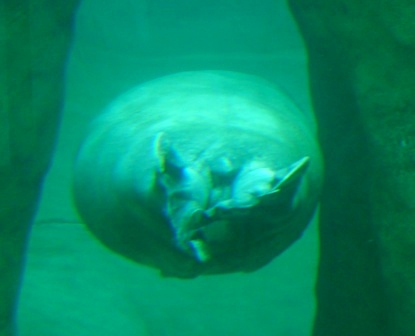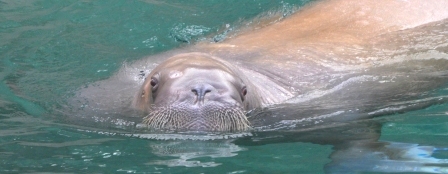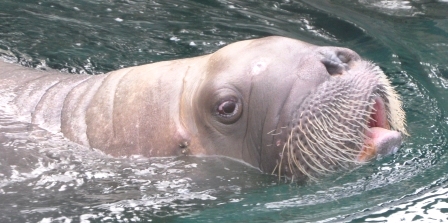Last Thursday, 16 July 2015, the Point Defiance Zoo and Aquarium announced the death of one of its most unique animals. “ET” was a walrus named after Stephen Spielberg’s famous movie character. Discovered as an orphaned calf in Prudhoe Bay, Alaska by oil workers in 1982 the “little” guy made his way to the zoo in Tacoma where he lived for the next 33 years. ET and his kind are truly fascinating animals. They join seals and sea lions in the order Pinnipedia, meaning “feather footed,” a reference to the shape of their fins but a name that sounds oddly delicate considering the size of these animals. At about 1 ton male walruses are the biggest pinnipeds in the Arctic and outweighed in their order only by the southern elephant seal. (We have a northern elephant seal here in the Northwest, one of which made a surprising appearance in downtown Port Townsend not long ago. More on that later.)
I can’t guarantee that this is the actual “ET” but it does show how entertaining and intriguing theses animals are to observe.
I have spent many enjoyable hours watching, photographing, and listening to ET at the Point Defiance zoo so it was sad to read of his passing. Along with two other walruses at the park he was an incredible sight above and below the water line. I thought I’d pass along a few photos and several intriguing facts about these extraordinary animals.
- Historical records show that walruses at one time extended into Ireland and as far south as northern Spain and along the coast of Germany
- The common name walrus comes from the Norse hvalroos, meaning “whale horse”
- Males are about twice the size of females
- Walruses change colors. They appear very light skinned, almost white in cold water but turn a noticeable pink in the sun due to blood flow
- That very obvious mustache is shared by both sexes and consists of 450 extremely sensitive bristles and are used to find the bivalves walruses love so much and are the among the most sensitive of all mammal whiskers
- Their ability to suck is so powerful that they are able to hold clams and mussels in their lips and suck the meat out without having to swallow the shell; the Inuit tell of walruses even sucking birds into their mouths from the surface of the water
- Males have a pair of pouches arising from the pharynx that extend along the sides of the neck; these fill with air and help to produce the numerous sounds that walruses make, the most intriguing is the distinctive, clear sound of a bell. These sacs also serve as a life preserver, keeping the animal afloat with little effort
- Tusks are used for defense and to maintain ice holes, not for digging up clams and such. They ram their head against the ice to open holes
References:
“A Complete Guide to Arctic Wildlife” by Richard Sale, copyright 2006
“Walker’s Mammals of the World, Volume II,” Richard M. Nowak, Sixth Edition
For more on ET at the PDZA follow this link:
HOOAH
Jack




Leave a Reply
You must be logged in to post a comment.